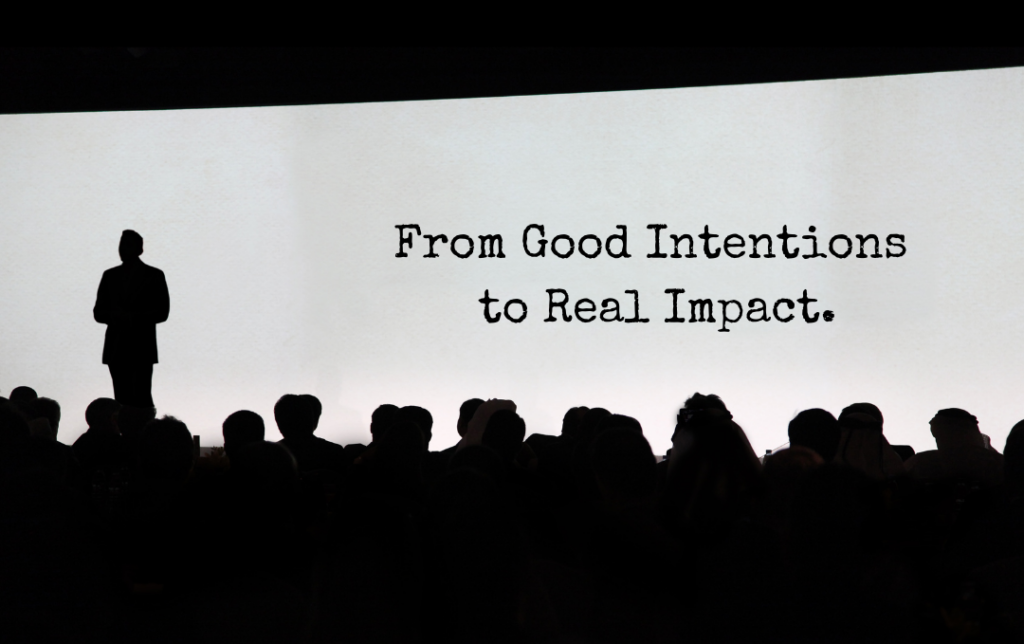Our government bodies, development organizations, and private firms, work on different projects, programs and policies that aim to make the lives of people better. This could be to provide healthcare and education for different segments of society, to design innovative services that create real value for users, or to create opportunities towards empowering individuals and communities. However, how do we know if these programs are even working? To find out, professionals from various sectors use Impact Evaluation.
What is Impact Evaluation?
Impact evaluation is a process of measuring whether a program or intervention has made a positive difference in achieving its goals. In this, we collect data, analyze the outcomes, and compare them to what would have happened had there been no intervention at all. The purpose is to help us understand how effective our program was, and then make decisions about whether or not we want to continue or modify it in any way.
In this blog, we delve into why learning impact evaluation helps us do better, more meaningful work, how we can learn and use it, and an overview of its role in various fields.
Why learn Impact Evaluation skills?
As stakeholders in the social science, health, and public policy sectors strive to allocate resources effectively, impact evaluation plays a crucial role in:
- Determining whether a program achieved its intended goals and objectives. This allows for evidence-based decision-making and continuous improvement.
- Identifying unintended consequences or negative outcomes. Valuable feedback is provided for program managers and policymakers to mitigate potential harm and improve program effectiveness.
- Building accountability and transparency. We can demonstrate to stakeholders, including funders, beneficiaries, and the wider public, that resources are being used effectively and efficiently towards achieving intended outcomes.
How can we develop those skills?
Given the increasing importance of impact evaluation in social science, health, and public policy, it is imperative for students and professionals in these fields develop strong data-driven evaluation skills. These skills include:
- Proficiency in statistical software (e.g., R, Python, or Stata) for data management, analysis, and visualization.
- Familiarity with experimental and quasi-experimental evaluation designs, such as RCTs, DID, IV, and RDD, to accurately estimate causal effects.
- Knowledge of econometric and statistical techniques for addressing endogeneity, selection bias, and other methodological challenges that may arise in impact evaluations.
Some avenues for acquiring these skills include:
- Pursuing specialized courses or workshops on impact evaluation methodologies, either through universities or professional development organizations.
- Participating in research or evaluation projects as part of internships, academic research, or professional work to apply and refine impact evaluation skills in real-world settings.
- (Our favorite option): Enrolling in atomcamp’s upcoming course ‘Impact Evaluation with Stata and R’! Where you will be learning the right technical tools and getting hands-on experience working with real data sets under the guidance of an expert trainer.
What using Impact Evaluation would look like:
Here are just a few ways this approach helps professionals and organizations in different fields work to ultimately improve the well-being of their target populations.
Social Sciences
To address important societal issues such as poverty, inequality, crime, and social cohesion, we need to make sure we have the right approach. By assessing the impact of different interventions, researchers can identify which programs are really working and why, providing evidence-based guidance for future policy-making and resource allocation decisions. For example, we can look at the impact of a community-based intervention aimed at reducing domestic violence in a particular area in Pakistan.
Health
Here, we can measure the effectiveness of various interventions, such as vaccination campaigns, health education programs, and access to healthcare services. These evaluations enable policymakers and healthcare providers to identify the best strategies for improving health outcomes and reducing disparities among different population groups. For example, we can determine whether a particular vaccine had a positive or negative impact on the spread of the coronavirus.
Climate Change
As the global community grapples with the effects of climate change, impact evaluation plays a critical role in determining the success of mitigation and adaptation measures. By assessing the impact of policies and programs on carbon emissions, energy efficiency, and climate resilience, we can better guide governments and organizations in their efforts to combat climate change and protect vulnerable populations. For example, we can measure whether a renewable energy program was successful in reducing greenhouse gas emissions and contribute to climate change mitigation positively.
Urban Planning
Urban planning professionals look to assess the effectiveness of land-use policies, transportation systems, and housing programs. These evaluations help planners create more sustainable, inclusive, and livable cities by providing evidence-based insights into how different interventions impact urban development, environmental quality, and social equity.
For example, the impact of a public transit project such as the Metro Bus on reducing traffic congestion and improving air quality in Lahore can be assessed.
Public Policy
Impact evaluations play a central role in informing public policy decisions. Policymakers rely on these evaluations to identify areas for improvement and ensure the best possible outcomes for their constituents. Impact evaluations contribute to more transparent, accountable, and evidence-based decision-making processes. For example, a study can evaluate the impact of a welfare program on poverty reduction and social inclusion for women in a chosen region.

